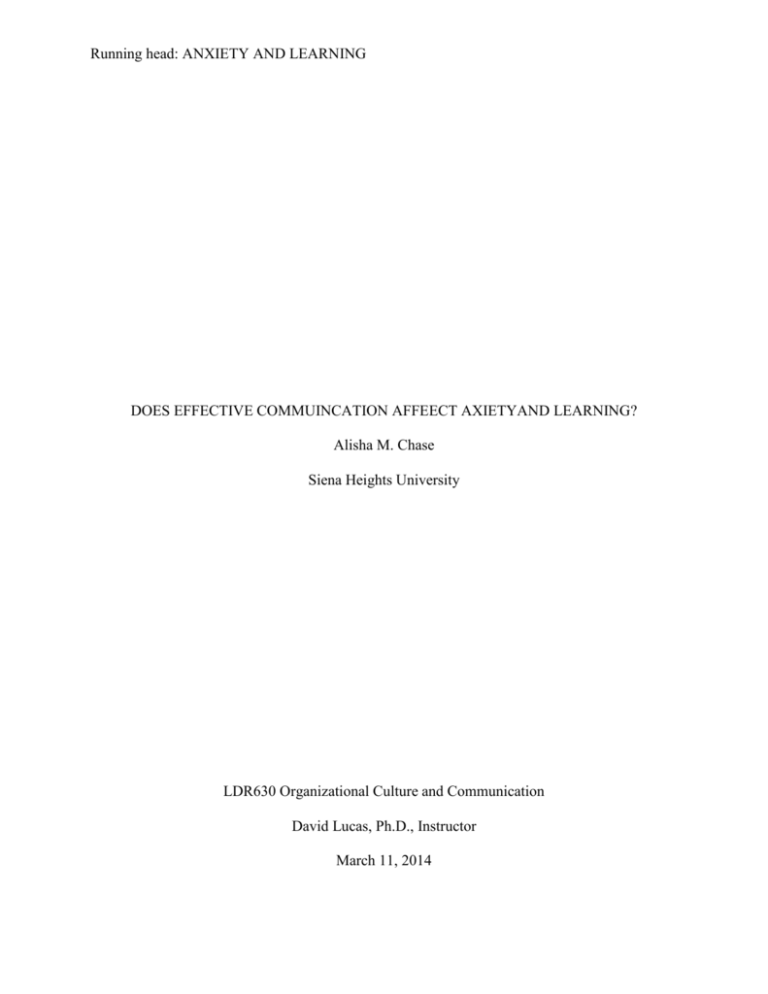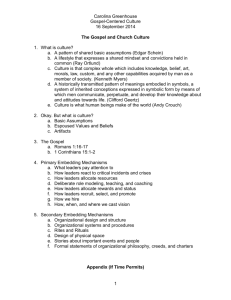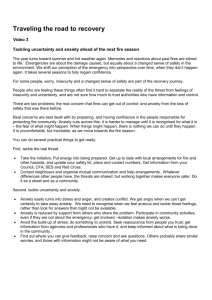File - Alisha Chase`s Portfolio
advertisement

Running head: ANXIETY AND LEARNING DOES EFFECTIVE COMMUINCATION AFFEECT AXIETYAND LEARNING? Alisha M. Chase Siena Heights University LDR630 Organizational Culture and Communication David Lucas, Ph.D., Instructor March 11, 2014 2 ANXIETY AND LEARNING Introduction I am doing something that I have never done before. I am starting my paper with a confession. I have always been the sort of individual who welcomes challenge and the ability to try new things; however, with my recent reorganization of duties and leaders, I have become one of those individuals who is cowering under the thought of change and learning something new. I have decided to do my individual research paper on communication and the affects it has on learning and anxiety. I chose this topic because I am a true believer that we all have the ability to shift our mental model. As we open ourselves up to knowledge we open ourselves up to opportunities. Therefore, I am hoping to therapeutically alleviate my anxiety of learning new duties as I construct my paper. What is Anxiety? Anxiety is a natural human behavior. We have all experienced at one point of our lives the un-calming feelings of rapid breathing, escalated heartbeat, perspiration, light headiness, and sometimes even shakiness. Although anxiety is unique to our body type, it is still a shared experience we can all easily converse about when discussing ventures into the unknown; whether within our personal or professional lives. Edgar Schein has stated within his writings that when organizations have the ability to embrace uncertainty with ease, they will be inherently more adaptive; therefore, putting them at a genuine advantage in today’s economy. Anxiety and Learning When Diane Coutu conducted an interview with Edgar Schein, he expressed that regardless of the amount of money, time, and enthusiasm leaders may put into the changed initiative, many of them still fail in their efforts. The learning transformation of the individuals 3 ANXIETY AND LEARNING who will be performing those duties is imperative to the success of the change. When a complete plan and vision is not clearly communicated, then the organization runs the chances of their employees performing the same processes but with a little tweak. Diane Coutu was documented saying, “Schein dismisses the popular notion that learning is fun; he focuses instead on the guilt and anxiety associated with radical relearning and draws some disturbing parallels between organizational learning and brainwashing. In the following conversation, Schein revisits his earlier work with American prisoners of war in Korea to explain what those experiences can teach us about interpersonal dynamics, learning, and corporate culture” (Coutu, 2002). Communication and Learning Styles I feel that it is very important that leaders understand that learning is specific to an individual; therefore, it is imperative that the teaching efforts and communication is tailored toward the appropriate audience. There are a variety of different learning styles an individual may have, I have taken the liberty of listing a few. Sensory Learners – The individual relies a lot on sensing, they tend to prefer what is familiar, and concentrate on facts instead of being innovative and adapting to new situations. Intuitive Learners – The individual relies a lot on intuition; therefore, running the possibility of missing important details. Visual Learners – The individual concentrates more on pictorial or graphical information. They receive information better when it is presented in ideas, concepts, and associated with images. Verbal Learners – The individual retains information better through listening. They 4 ANXIETY AND LEARNING tend to have difficulty with instructions that are written. Active Learners – The individual tends to act before thinking. They make hasty decisions. Reflective Learners – The individual tends to reflect a lot; therefore, learning from experiences and actions. Sequential Learners – The individual likes to break things down into small components and is often able to dive right into problem solving. Global Learners – This individual grasp the big picture with ease. They tend to be intuitive decision-makers; interpersonal connections are very important; they solve complex problems and put things together in innovative ways. Below I have provided a graph that identifies the different learning styles and the best taught approaches for those particular styles. Learning Styles Modality Visual Learners (input) Descriptors Learn by observation Can recall what they have seen Can follow written or drawn instructions Like to read Use written notes Benefit by visualizing, watching TV/video/films Learn Best Through the Use of ... Charts, graphs, diagrams, and flow charts Sight words Flashcards Visual similarities and differences Pictures and graphics Maps Silent reading Written instructions Computer assisted learning 5 ANXIETY AND LEARNING Auditory Learners (input) Verbal-Linguistic Intelligence Kinesthetic Learners (input) Tactile Learners (input) Prefer listening and taking notes Listen for patterns Consult peers to ascertain that they have the correct details Can recall what they have heard Can follow oral directions Repeat words aloud for memorization Use oral language effectively Discussion, dialog, debate Memorization Phonics Oral reading Hearing anecdotes or stories Listening to tapes or CDs Cooperative learning groups Are often physically adept Learn through experience and physical activity Benefit from demonstration Learn from teaching others what they know Playing games Role playing Read body language/gestures Mime Drama Learn or memorize while moving (pacing, stationary bike, finger or whole body games) Learn by touching and manipulating objects Often learn inductively rather than deductively Tend toward psychomotor over abstract thinking Prefer personal connections to topics Follow directions they have written themselves / that they have rehearsed Benefit from demonstrations Learning by doing "Hands-on" Creating maps Building models Art projects Using manipulative Drawing, designing things Writing / tracing 6 ANXIETY AND LEARNING Active Reflective Global Understanding Analytical Understanding Can be impulsive Risk-takers Do not prefer lectures Prefer group work Tend to be interpersonal Not inclined to too much note-taking Prefer to think about concepts quietly before any action Learn by thinking Like writing Tend to be intrapersonal and introspective Make decisions based on intuition Spontaneous and creative; "idea" person Often a risk-taker Tend to reach conclusions quickly Intake information in large chunks rather than details Nonlinear thinkers "See the forest before they see the trees." Sequential, linear learners Prefer information in small chunks, steps Can follow the rules for mathematic equations Prefer a logical progression "See the trees before they see the forest." Prefer "doing, discussing, explaining" vs. listening and watching Prefer active experimentation Like acting and role playing Like team competition Tend toward deductive learning Prefer reflective observation Intrapersonal skills valued Journals Learning logs Interpersonal connection important to them Stories and anecdotes Seeing the "whole" rather than in parts Highly interesting project and materials Functional games and activities Think-pair-share; Praisequestion-polish Teacher feedback; person-toperson communication Intrapersonal skills valued Journals Learning logs Sequentially organized material, timelines, diagrams Moving from "part" to the "whole" Puzzles, logic games 7 ANXIETY AND LEARNING Emotional Impact on Organizational Learning Within the article by Russ Vince he states, “Emotion in organizations has tended to be seen as ‘uncomfortable knowledge’, and has consequently been avoided or ignored. This idea, that emotion is somehow ‘not a part of the job’ and can ‘get in the way’ of effectiveness is pervasive. Also, in one sense it is true, our emotional responses – particularly fears and anxieties – can and do get in the way, but they can also provide the basis for learning, both individually and collectively. For the individual, anxiety may be provoked by having to say something difficult or challenging, by the effects of unwanted decisions, by the pressures of an unfamiliar task” (Vince, 2002, P. 6). Russ’s article explores the Goodwill Company and the techniques he felt they could have adopted during an organizational transition. Russ believes that when you center your techniques on empowering individuals you have a higher chance of influencing the employee’s learning abilities and the productivity that is derived from that positive transition. How Emotional Intelligence Affects Learning and Anxiety Emotional intelligence is the capacity to be aware of other’s emotions; it defines your ability to be empathetic in various situations. Thus, I feel emotional intelligence plays a big part in communicating organizational change in a manner to where an employee’s anxiety and learning experience does not overcome them. Since anxiety is created around the unknown, a leader or organization’s approach to communicating that change can put employees in a place of comfort or discomfort. Christopher Chan states within his article that, “Overall, these findings suggest that individuals with higher levels of emotional intelligence are more likely to act in 8 ANXIETY AND LEARNING considerate and socially adaptable ways and so emotional intelligence offers invaluable advantages to organizations experiencing continuous change” (Chan, 2004). Communication and the Effects on Learning and Anxiety Good communicational skills are paramount to any successful initiatives; the more effective your communicational skills, the smoother the transition. Lawrence Robinson states, “Effective communication helps us better understand a person or situation and enables us to resolve differences, build trust and respect, and create environments where creative ideas, problem solving, affection, and caring can flourish” (Lawrence Robinson, 2014). It is my belief that leaders are able to reduce employee’s anxiety when learning new obligations within an organizational change by simply strategically streamlining their communicational techniques, such as: Explaining the nature or reason for the change. This is a wonderful time for organizations to be as transparent as possible to their employees. Informing the employees of what role they will play in the change or process. This brings the employees closer to the vision and project. Observing the body language as well as the verbally communicated resistance of the employee. This will assist the leader in truly identifying where the anxiety within the individual(s) lies. The leader stepping up and displaying his commitment and dedication for the change thru communication. This provides the image of confidence and will ease the notion that the change will be a negative experience. 9 ANXIETY AND LEARNING Developing communication plans. These forms of plans ensures the way-ahead for the organization’s vision is well known across the board; it helps foster lingering questions and concerns; and it also assist with detailing roles and responsibilities. Effective communication has the capability of creating a sense of stability amongst the organization; and therefore reduces the anxiety of the unknown. Edgar Schein states, “Human minds needs cognitive stability and any challenge of a basic assumption will release anxiety and defensiveness”. (Schein, 1985) The below diagram focuses on the fact that communication is core and built around established trust, employee empowerment, and building shared vision; organizations have the opportunity to foster effective learning when they incorporate the ability to emotionally connect with the employees, present transparency when communicating, and tailor the type of communication conveyed. (Chan, 2004) Coping With Change 10 ANXIETY AND LEARNING The effects of anxiety can cause a person to feel overwhelmed, dizzy, or even initiate fear. Lauren Johnson stated, “In such times, calls to change can also provoke especially intense resistance. When uncertainty is such a prominent — and threatening — feature on the external landscape, people crave constancy and routine inside their organizations. Managers, then, face a daunting task. To help their organizations weather a downturn, they need to ensure that employees fully buy into change initiatives and make the necessary alterations in their dayto-day behavior–at precisely the same time their employees are likely to be most anxious about, and resistant to, change” (Johnson, 2009). The article communicates that there are five phases of change that employees may experience, such as: Stagnation which is the failure to progress or advance. Usually when an organization realizes that they cannot continue in the current state that they are in, they look for change. Preparation is the phase that leaders decide to make the announcement of change within the organization. If communicated effectively, managers and employees can range from the emotional stages of fear to relief and then finally excitement. Implementation is the phase where leaders announce new assignments, define new reporting lines, or mandate new processes. In addition to feelings of threat, fear, and uncertainty. The employees may also experience confusion, resentment, worries about inadequacy, or exhilaration. Determination is the phase where the changes haven’t been deeply rooted yet, but the leaders and the organization are indomitable about ensuring that the change is successful. Fruition is the phase where the hard work, good communicational plans, and the employees’ determination starts to become tangible and confidence begins to arise. 11 ANXIETY AND LEARNING The importance message is that it is imperative leaders consistently deliver a message of confident, never abandon the emotions of their employees, shepherd the employees through their emotional ups and downs, and communicate with the workforce frequently. Conclusion So, you may wonder what have I learned. I have learned that emotional connection between anxiety and learning is inevitable. Therefore, it is extremely important that organizations and leaders careful implement techniques that will lessen the impact of change. Effective communication is the key. It has the ability to ensure a successful communication plan is conveyed to the workforce, display empathy and emotional intelligence, and assist employees with coping with the idea of change. Additionally, I have taken from my research that it is equally important that I take responsibility and communicate my concerns, ask questions, and reflect on the great potentials of my newly aligned organization and not the past. I leave you with this quote, “Change is hard because people overestimate the value of what they have—and underestimate the value of what they may gain by giving that up." ~ James Belasco and Ralph Stayer 12 ANXIETY AND LEARNING References Chan, B. S.-L. (2004, April). Wiley InterScience. Retrieved from Emotional intelligence and participation in decision-making: strategies for promoting organizational learning and change: http://courses.washington.edu/nutrmgmt/564_ArticlesUsed_07/ScottLadd_OrgChange_0 5.pdf Coutu, D. L. (2002, March). Harvard Business Review. Retrieved from The Anxiety of Learning: http://hbr.org/2002/03/the-anxiety-of-learning/ar/1 Johnson, L. K. (2009, January 14). HBR Blog Network . Retrieved from Helping Employees Cope with Change: Helping Employees Cope with Change Lawrence Robinson, J. S. (2014, February). HelpGuide. Retrieved from Effective Communication Improving Communication Skills in Business and Relationships: http://www.helpguide.org/mental/effective_communication_skills.htm Schein, E. (1985). Organizational Culture and Leadership. Jossey-Bass Business & Management. Stayer, J. B. (1994). Leading Thoughts; Bulding a Community of Leaders. Retrieved from Quotes on Change: http://www.leadershipnow.com/changequotes.html Vince, R. (2002). The impact of emotion on organizational. The Business School.






